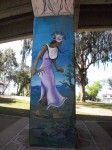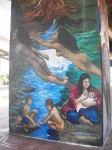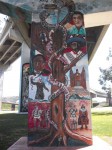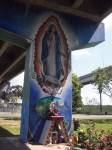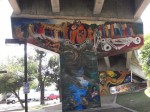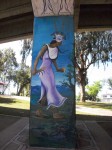The story of La Llorona is one of those legends from Mexico that has crossed the border to the Chicano community, largely due to its support through oral history. Many members of my family and friends who know the story, originally heard it through word of mouth. I heard it first, like many other children, as a story of warning from the adults in my family. The way I heard it, a young couple who lived in a small village in Mexico, had just had two boy twins. Soon after, the man left without a trace. The woman, so upset over her husband’s disappearance, ended up drowning her newborn children in the nearby river. Eventually the grief and the guilt ended up killing her. As a result, her ghost haunted the same river where she could be heard late at night, to this day, screaming out loud, “Ay mis hijos!” If any of us or my cousins found ourselves outside, late at night, La Llorona would snatch us up as her children and drown us.
My mother on the other hand, heard it from her friends when they shared scary stories from their hometown. The story had been appropriated, as it often was, by the small city in San Luis. Thus the story was told as having happened “to a friend of a friend” who had seen her in the nearby river. She was said to be found weeping, or flying over houses in her white garb. She admitted to never having reconfirmed it within her family, although the legend was brought up later in one of her elementary school books that cited it as an example of legends in the culture and part of literature. A friend of my mom’s, from an older generation, stated that she heard a version of the story set in the Colombian era. She’d heard that the woman was an “india” who fell in love with a Spanish “general.” He did not lover her back. Thus she drowned her children thinking they were the source of his dislike. Feeling guilty for what she had done, she committed suicide. Her soul then grieved and cried for her children.
‘The Spirit of La Llorona’, a site dedicated to La Llorona, presents 4 primary versions, and a timeline linking the historical figure, La Malinche, to the tale of La Llorona. One of the versions in the site revolves around the idea of La Llorona as a virgin (invoking ideas of the Virgin Mary) who had gotten pregnant without “having been with a man.” Her father ended up throwing the baby into the river. The mother disappeared and was soon followed by apparitions in the river of a young woman holding a child, weeping, still seen to this day.
Film adaptations of La Llorona have been made, including a recently animated film from Mexico: ‘La Leyenda de la Llorona’ released on October 21, 2011. The 2007 version, ‘The Cry: La Llorona’ set, and made in the United States, has adapted its own version of the history of Malinche. This history can also be found in ‘The Spirit of La Llorona’ website. It places La Malinche as a woman who killed her own twin boys the she had had with Hernán Cortés after one of the gods told her that if she let him take them back to Spain, one of them would return to kill the rest of her people. As a matter of fact, Malinche, born at the turn of the 16th century from a noble Nahua family, was later presented as a slave to Hernán Cortés. From slave she went to translator, then mistress, and bore his son, Martín Cortés (although he had another son by another woman, of the same name). Martín Cortés sailed to Spain with his father, then back to Mexico, before being exiled to Spain where he married and eventually passed away.
Another origin given to the legend of La Llorona dates even further back in Aztec mythology with Cihuacoatl, the “woman-snake” and goddess of midwifery. She is said to have been the first woman cited near a river crying for her children, the Aztecs. It was later interpreted as an omen of the coming of the conquistadors and the massacre of the natives of Mexico.
The Spirit of La Llorona cite can be found here, I highly recommend navigating through it-
http://www.lallorona.com/La_index.asp
The recent animated film (in Spanish) –
http://www.youtube.com/watch?v=aE0a3hvBaFQ&feature=related
Additional Sources:
http://archive.suite101.com/article.cfm/history_mexico/58848
http://www.lallorona.com/1legend.html
Miller, Mary Ellen., and Karl A. Taube. An Illustrated Dictionary of the Gods and Symbols of Ancient Mexico and the Maya. New York: Thames and Hudson, 2011. Print.
 Gloria Anzaldúa, Borderlands (1-91)
Gloria Anzaldúa, Borderlands (1-91)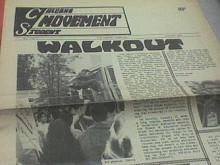
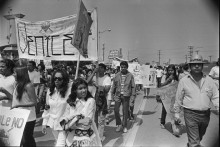
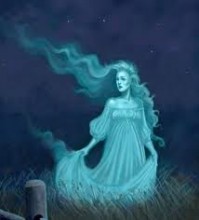

 I picked up the first thing that caught my eye. It was a thin pamphlet, in photocopied black and white, with an anarchy symbol and the title “Anarchist Queer Person of Color” handwritten across the front. Cautiously I opened it. I read its intoxicating eight pages three times in quick succession. I closed it, and looked around, wondering how my mind could have expanded so vastly without anyone around me noticing. I read it once again, slowly, letting each of the ideas it presented bounce around in my headspace and develop. Truthfully, the zine presented me with more questions that answers. In light of this Chicana Feminism class I find myself in, I was left with, and am still left with, one main question: Is anarchy the natural progression of feminism, especially for women of color?
I picked up the first thing that caught my eye. It was a thin pamphlet, in photocopied black and white, with an anarchy symbol and the title “Anarchist Queer Person of Color” handwritten across the front. Cautiously I opened it. I read its intoxicating eight pages three times in quick succession. I closed it, and looked around, wondering how my mind could have expanded so vastly without anyone around me noticing. I read it once again, slowly, letting each of the ideas it presented bounce around in my headspace and develop. Truthfully, the zine presented me with more questions that answers. In light of this Chicana Feminism class I find myself in, I was left with, and am still left with, one main question: Is anarchy the natural progression of feminism, especially for women of color?
